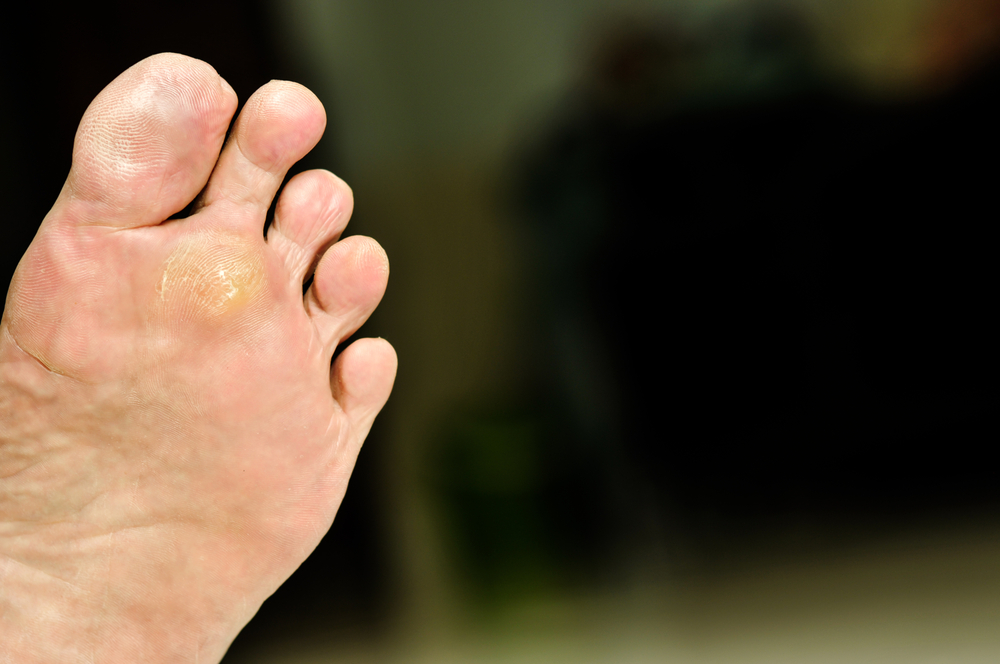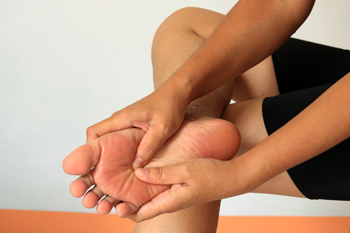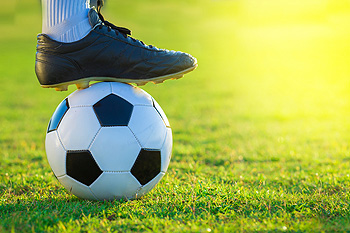
(616) 846-3400
Fax: (616) 846-3406

(616) 846-3400
Fax: (616) 846-3406
 Warts on the bottom of the feet, known as plantar warts, are a common condition. About 25% of people get plantar warts at some point in their lifetime, often during childhood or adolescence. Plantar warts are caused by the human papillomavirus, also known as HPV, and can be highly contagious. To prevent plantar warts, avoid walking barefoot in damp public areas, such as community swimming pools or water parks. Wear clean cotton socks and change them regularly. Inspect your feet and take extra precautions if you notice a cut or scratch, as these may make you more susceptible to infection. If you or someone close to you has a plantar wart, it is suggested to keep it covered with a bandage in order to avoid spreading the virus to others. To avoid the risk of contagion or infection, it is recommended that you consult with a podiatrist right away.
Warts on the bottom of the feet, known as plantar warts, are a common condition. About 25% of people get plantar warts at some point in their lifetime, often during childhood or adolescence. Plantar warts are caused by the human papillomavirus, also known as HPV, and can be highly contagious. To prevent plantar warts, avoid walking barefoot in damp public areas, such as community swimming pools or water parks. Wear clean cotton socks and change them regularly. Inspect your feet and take extra precautions if you notice a cut or scratch, as these may make you more susceptible to infection. If you or someone close to you has a plantar wart, it is suggested to keep it covered with a bandage in order to avoid spreading the virus to others. To avoid the risk of contagion or infection, it is recommended that you consult with a podiatrist right away.
Plantar warts can be very uncomfortable. If you need your feet checked, contact Dr. Robbi Young from Grand Haven Foot & Ankle. Our doctor will assist you with all of your foot and ankle needs.
About Plantar Warts
Plantar warts are the result of HPV, or human papillomavirus, getting into open wounds on the feet. They are mostly found on the heels or balls of the feet.
While plantar warts are generally harmless, those experiencing excessive pain or those suffering from diabetes or a compromised immune system require immediate medical care. Plantar warts are easily diagnosed, usually through scraping off a bit of rough skin or by getting a biopsy.
Symptoms
Treatment
To help prevent developing plantar warts, avoid walking barefoot over abrasive surfaces that can cause cuts or wounds for HPV to get into. Avoiding direct contact with other warts, as well as not picking or rubbing existing warts, can help prevent the further spread of plantar warts. However, if you think you have developed plantar warts, speak to your podiatrist. He or she can diagnose the warts on your feet and recommend the appropriate treatment options.
If you have any questions please feel free to contact our office located in Grand Haven, MI . We offer the newest diagnostic and treatment technologies for all your foot and ankle needs.
 Each foot consists of twenty six bones, numerous ligaments, muscles, and tendons. Everyday wear and tear or an injury can compromise general foot function, and uncomfortable foot conditions may occur. A bunion is a bony formation that develops on the side of the big toe, and can happen from wearing shoes that do not fit correctly. Blisters can occur on the back of the heel or on the bottom of the feet, and this is generally a result of increased friction. A corn is a hardened area that can gradually develop on top of the toes or between them, and can cause severe pain and discomfort. If you have these or other conditions that can lead to chronic foot pain, it is strongly advised that you are under the care of a podiatrist who can guide you toward proper treatment techniques.
Each foot consists of twenty six bones, numerous ligaments, muscles, and tendons. Everyday wear and tear or an injury can compromise general foot function, and uncomfortable foot conditions may occur. A bunion is a bony formation that develops on the side of the big toe, and can happen from wearing shoes that do not fit correctly. Blisters can occur on the back of the heel or on the bottom of the feet, and this is generally a result of increased friction. A corn is a hardened area that can gradually develop on top of the toes or between them, and can cause severe pain and discomfort. If you have these or other conditions that can lead to chronic foot pain, it is strongly advised that you are under the care of a podiatrist who can guide you toward proper treatment techniques.
Foot Pain
Foot pain can be extremely painful and debilitating. If you have a foot pain, consult with Dr. Robbi Young from Grand Haven Foot & Ankle. Our doctor will assess your condition and provide you with quality foot and ankle treatment.
Causes
Foot pain is a very broad condition that could be caused by one or more ailments. The most common include:
Diagnosis
To figure out the cause of foot pain, podiatrists utilize several different methods. This can range from simple visual inspections and sensation tests to X-rays and MRI scans. Prior medical history, family medical history, and any recent physical traumatic events will all be taken into consideration for a proper diagnosis.
Treatment
Treatment depends upon the cause of the foot pain. Whether it is resting, staying off the foot, or having surgery; podiatrists have a number of treatment options available for foot pain.
If you have any questions, please feel free to contact our office located in Grand Haven, MI . We offer the newest diagnostic and treatment technologies for all your foot care needs.
 Athlete’s foot, also known as tinea pedis in the medical community, is a fungal infection of the feet that is also highly contagious. Athlete’s foot typically may spread in warm and moist environments including public swimming pools, locker rooms, gyms, and communal showers. There are a few symptoms that may indicate the infection is present. These may include dry, scaly, or cracked skin, usually between the toes. The skin may appear flushed or raw, and the toenails may become weak and discolored. Blisters may also form on the feet, and in serious conditions can crack and ooze. Some patients may also experience an itchy sensation. In order to receive a proper diagnosis and relieve the discomfort of symptoms, it’s suggested that you consult with a podiatrist.
Athlete’s foot, also known as tinea pedis in the medical community, is a fungal infection of the feet that is also highly contagious. Athlete’s foot typically may spread in warm and moist environments including public swimming pools, locker rooms, gyms, and communal showers. There are a few symptoms that may indicate the infection is present. These may include dry, scaly, or cracked skin, usually between the toes. The skin may appear flushed or raw, and the toenails may become weak and discolored. Blisters may also form on the feet, and in serious conditions can crack and ooze. Some patients may also experience an itchy sensation. In order to receive a proper diagnosis and relieve the discomfort of symptoms, it’s suggested that you consult with a podiatrist.
Athlete’s foot is an inconvenient condition that can be easily reduced with the proper treatment. If you have any concerns about your feet and ankles, contact Dr. Robbi Young from Grand Haven Foot & Ankle. Our doctor will treat your foot and ankle needs.
Athlete’s Foot: The Sole Story
Athlete's foot, also known as tinea pedis, can be an extremely contagious foot infection. It is commonly contracted in public changing areas and bathrooms, dormitory style living quarters, around locker rooms and public swimming pools, or anywhere your feet often come into contact with other people.
Solutions to Combat Athlete’s Foot
Athlete’s foot can cause many irritating symptoms such as dry and flaking skin, itching, and redness. Some more severe symptoms can include bleeding and cracked skin, intense itching and burning, and even pain when walking. In the worst cases, Athlete’s foot can cause blistering as well. Speak to your podiatrist for a better understanding of the different causes of Athlete’s foot, as well as help in determining which treatment options are best for you.
If you have any questions please feel free to contact our office located in Grand Haven, MI . We offer the newest diagnostic and treatment technologies for all your foot and ankle needs.
 Turf toe, as the name suggests, is a sprain of the big toe joint that is especially common among athletes who play on artificial turf. This type of sprain often occurs during sporting activities such as football, soccer, gymnastics, and basketball. This injury is typically the result from jamming the toe or due to repeated injury when initially pushing off to begin jumping or running. The constant upward bending of the big toe joint can lead to a sprain. Symptoms may include pain, swelling, and limited joint movement that gradually worsens due to a repetitive action. To confirm that the toe is not broken, an X-Ray will need to be taken. If you believe you are suffering from turf toe, it is highly recommended that you are under the care of a podiatrist who will be able to diagnose and treat this condition.
Turf toe, as the name suggests, is a sprain of the big toe joint that is especially common among athletes who play on artificial turf. This type of sprain often occurs during sporting activities such as football, soccer, gymnastics, and basketball. This injury is typically the result from jamming the toe or due to repeated injury when initially pushing off to begin jumping or running. The constant upward bending of the big toe joint can lead to a sprain. Symptoms may include pain, swelling, and limited joint movement that gradually worsens due to a repetitive action. To confirm that the toe is not broken, an X-Ray will need to be taken. If you believe you are suffering from turf toe, it is highly recommended that you are under the care of a podiatrist who will be able to diagnose and treat this condition.
Ankle and foot injuries are common among athletes and in many sports. They can be caused by several problems and may be potentially serious. If you are feeling pain or think you were injured in a sporting event or when exercising, consult with Dr. Robbi Young from Grand Haven Foot & Ankle. Our doctor will assess your condition and provide you with quality foot and ankle treatment.
Common Injuries
The most common injuries that occur in sporting activities include:
Symptoms
Symptoms vary depending upon the injury and in some cases, there may be no symptoms at all. However, in most cases, some form of symptom is experienced. Pain, aching, burning, bruising, tenderness, tightness or stiffness, sensation loss, difficulty moving, and swelling are the most common symptoms.
Treatment
Just as symptoms vary depending upon the injury, so do treatment options. A common treatment method is known as the RICE method. This method involves rest, applying ice, compression and elevating the afflicted foot or ankle. If the injury appears to be more serious, surgery might be required, such as arthroscopic or reconstructive surgery. Lastly, rehabilitation or therapy might be needed to gain full functionality in the afflicted area. Any discomfort experienced by an athlete must be evaluated by a licensed, reputable medical professional.
If you have any questions, please feel free to contact our office located in Grand Haven, MI . We offer the newest diagnostic and treatment technologies for all your foot care needs.